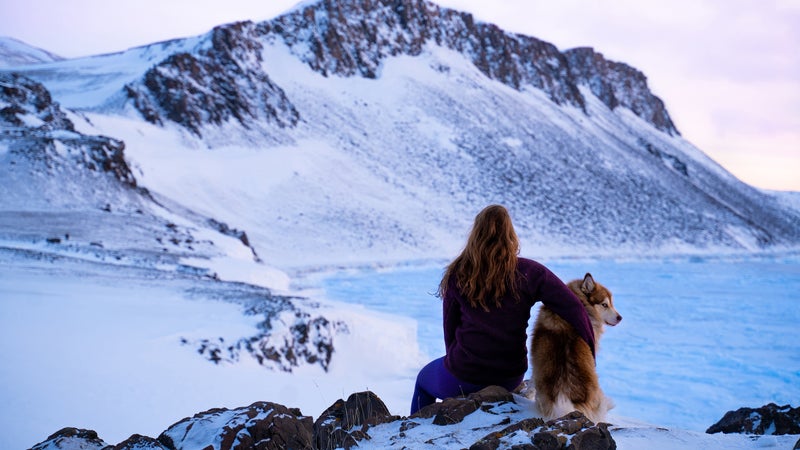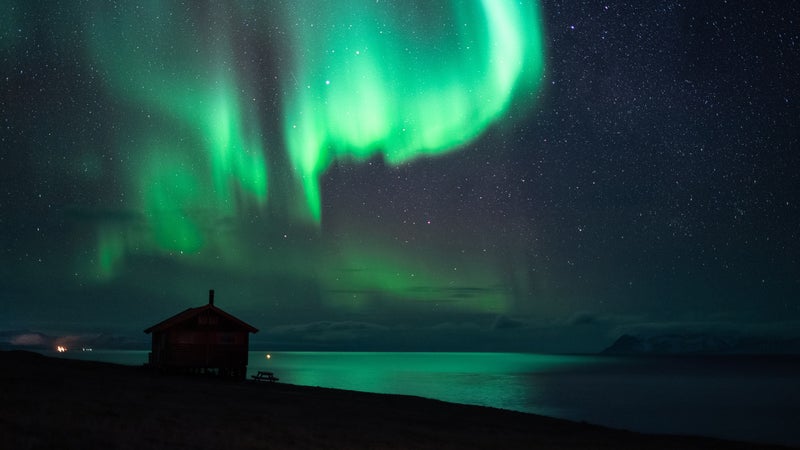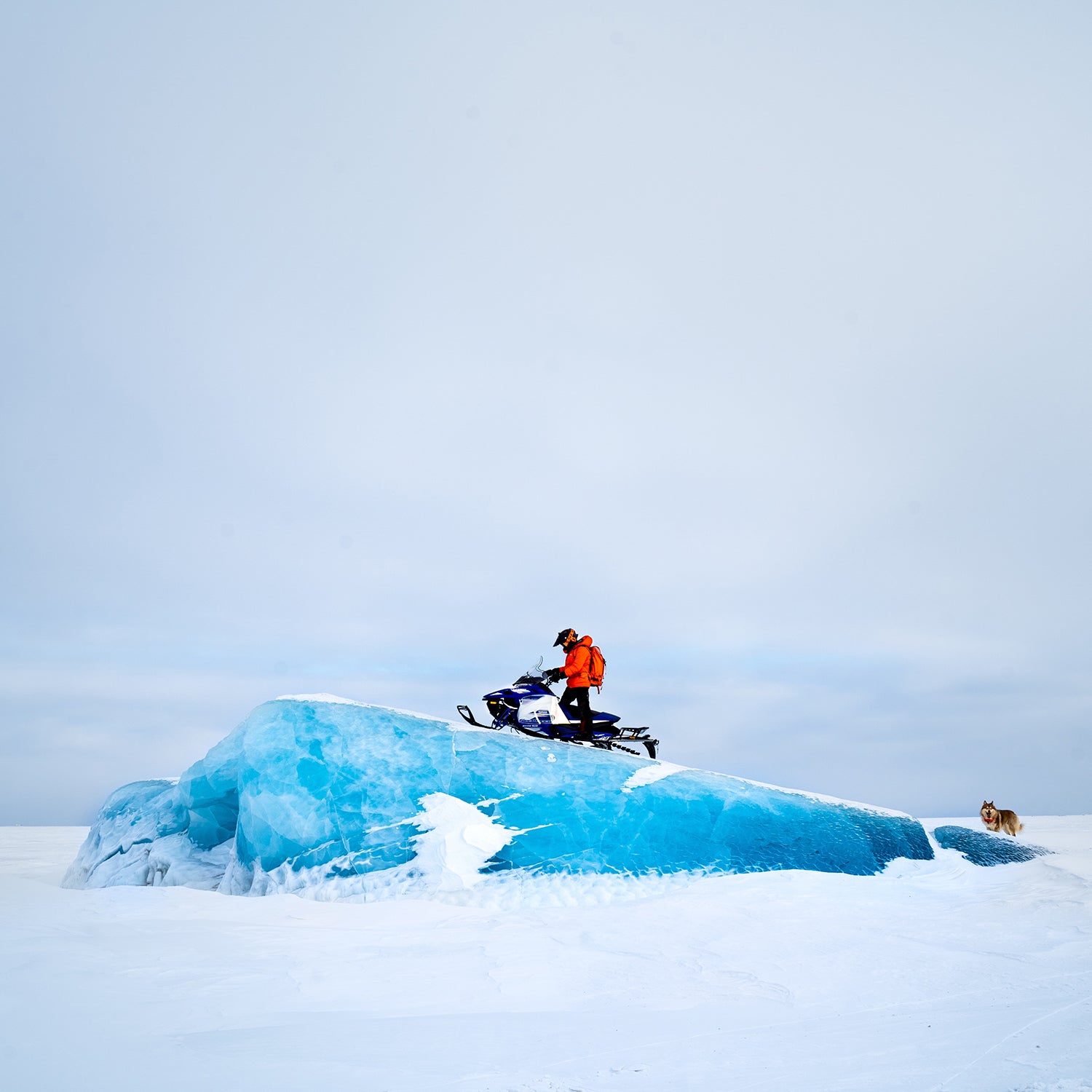Cecilia Blomdahl stands in the entryway of her cabin, panning the camera to reveal a body of water glittering with light from the midnight sun. In the distance, you can just make out the seven glaciers she can�� from her living room. In typical fashion, Blomdahl begins the with a friendly introduction: “My name is Cecilia, and I live on Svalbard, an island close to the North Pole,” she says with the practiced air of someone who spent years working in the hospitality industry. She sprinkles in bits of trivia about the��Arctic’s long days��as an electronic track by Kina Beats plays in the background.
Blomdahl, a self-taught photographer and videographer, has lived on the Norwegian archipelago of Svalbard for the past five years. Since her ,��in��October, she’s gained a million followers and 15 million likes on the app, reeling in viewers with everything from drone footage of the tundra’s expanse to explanatory videos about life in the Arctic.
For viewers who’ve spent a year in quarantine, Blomdahl’s TikToks don’t just offer an escape to a world unaffected by COVID-19 (Svalbard is one of the that’s never had a reported case) or a soothing antidote to . They also offer a surprising sense of familiarity, allowing us to virtually slip into the lifestyle of someone who has made the most of her time in an isolated environment, one that’s��not altogether different from the social isolation we were all��plunged into during the pandemic.
Originally from Sweden, Blomdahl spent part of her youth in Ireland, and has since lived all over the world while��going to school��and working at luxury hotels. She moved to Svalbard in 2015 with her then��partner, intending��to head the��reservations department at a restaurant for just a few months, but she soon fell in love with the island. With its lack of visa requirements, Svalbard—long a hub for Arctic exploration, coal mining, and research—has drawn an international population of residents who stay anywhere between several��months and several decades. They’re a group of folks who are perhaps more daring, self-reliant, and up for a good challenge than most. When Blomdahl and her partner broke up and he moved away, she stayed for the work-life balance, community, and sense of adventure that the island afforded.
Now��Blomdahl works part-time at a clothing store and lives with her current partner, whom she met at her first job on Svalbard. Because housing is hard to find, they bought a cabin without running water just outside Longyearbyen, the world’s northernmost settlement, with a population of 2,368.

Though she’s had an ��for years, she began focusing on building her social media presence after moving to Svalbard. A��self-proclaimed techie, Blomdahl became interested in photography when she picked up a drone in 2017 and was instantly mesmerized by the aerial view of the island. “It’s like a live-version��video game,” she says.
She bought a camera and taught herself photography, posting her initial attempts at capturing the northern lights on Instagram. Her work��slowly gained traction, but it didn’t really take off until she started a TikTok account��last fall. One of her��first posts, about what she sees on a during the polar night, went viral. “She realized that when she was on Svalbard, she had a kind of niche,” says her younger sister, Camille. “She took it to the next level with the drones.”
Since then, Blomdahl has captured viewers’ attention with tours of the tundra, where we�� at sights like the aurora borealis and the set deep within the permafrost, preserving over a million seed samples for future generations. She documents seals, reindeer, and a population of that outnumber human inhabitants on Svalbard.
Blomdahl expected that most viewers would crave this adventurous content but��was initially surprised at the number of followers asking about her everyday life. A quick scroll through the comments section on a TikTok about reveals a chorus of sentiments like “I can’t imagine living without Amazon Prime!” Many viewers don’t care as much about snowmobiling or glacier hikes. What they want to know is whether she goes to the movie theater or what she eats.
So Blomdahl delivers with behind-the-scenes footage. We how she layers up with expedition pants, thermals, and a firearm ( in Svalbard as protection from polar bears) to walk her gloriously fluffy Finnish Lapphund, Grim, in a snowstorm. We accompany her to the local supermarket to stock up on groceries with exorbitant prices (an avocado is $4). She where she grabs a snack (a taco truck) and what color she’s selected for her latest manicure (orange).
I stumbled across Blomdahl’s profile over the winter. Back then��she’d only posted a handful of videos, which I promptly scrolled through, leaving me sitting on the couch in a cramped New York City apartment, a world away from indoor dining and outdoor adventures, pondering why I was so intrigued by her work.
Blomdahl believes her videos are popular because they’re presented in watchable packages. She spends time finding music that fits the��vibe and sticks to a format she established early on: many videos start with slow-motion nature footage and include a montage in the middle. “I want to be a positive corner on the internet,” she says. “I have gotten a lot of feedback from people saying that my videos help with their anxiety��and that they find them super peaceful to watch.”
She also suspects her videos are attractive because they’re different from what you might expect—she’s just a regular person living in an unusual place. She��offers��us familiar points of entry into an exciting world by showing how she decorates her cabin with fairy lights or makes her morning cup of coffee. She models the allure of a self-structured lifestyle.
Remember the era of sourdough bread starters? Cottage core? Foraging? Homesteading? These hobbies that cropped up during the pandemic were all about creating meaning through self-reliance when so much, including routines providing structure and socialization, had been��taken away. When Blomdahl started making TikTok videos��in 2020, they seemed perfectly timed for our��new DIY age. She says that being able to do things herself—whether it’s speeding around on her turbo snowmobile, hiking in the mountains with a shotgun on her back, or fishing in the summer—gives her a sense of accomplishment. “It just empowers me,” she says. “I feel so free, and I feel so able.” By inviting viewers into this world, Blomdahl makes a meaningful life in an isolated environment look easy, normalizing a lifestyle that to many seems extreme.
Of course, living in the Arctic comes with its��fair share of challenges, and I asked Blomdahl about that over a Zoom call. She says she takes vitamin supplements and has a strict sleeping schedule to maintain a sense of normalcy during the polar night, which lasts 24 hours a day for two and a half��months. But it also doesn’t hurt that she’s had the privilege of opting in to this lifestyle, where she sees her sacrifices as a worthwhile trade-off for the incredible views.
For those of us��who haven’t had that freedom of choice recently, Blomdahl��has some��takeaways as a person��who’s lived in relative isolation for a few years. While��enduring the polar night might not seem like the most relatable experience, it’s��a season that forces you to actively consider how you spend your time and find meaningful moments. “It kind of makes you focus on different things that you wouldn’t normally,” she says. Blomdahl has learned to focus on what each extreme season has to offer and put her happiness into small things, like starting her day with a cup of coffee.

While in quarantine last winter, I found myself lighting candles and hanging��lights in every corner of the apartment. Watching Blomdahl’s videos allowed me to live vicariously through someone who had successfully found the joyful moments that I hoped to emulate in my own space. She ultimately teaches us to take the time to find joy and adventure in the mundane��when possible, whether by cooking for a loved one, spending virtual time with friends, or transforming your living room into a sacred space.
Perhaps surprisingly, polar night has become��Blomdahl’s favorite time of year. This extreme circumstances create a unifying sense of community throughout the village, she says, which encourages social activities like art festivals and snowmobiling. It’s not unlike the way living through the singular experience of the pandemic and watching those close to us weather monumental challenges may have strengthened relationships between family members, partners, or friends in a .
“I would say the whole village,��it feels like we are one in this, because we all go through this polar night together,” says Blomdahl. “It’s just so private in a weird way. It’s like our own little universe.” By sharing this microcosm on TikTok, she welcomes��us into that fold, allowing us to become an extension of a��community that previously might have seemed a world away.


